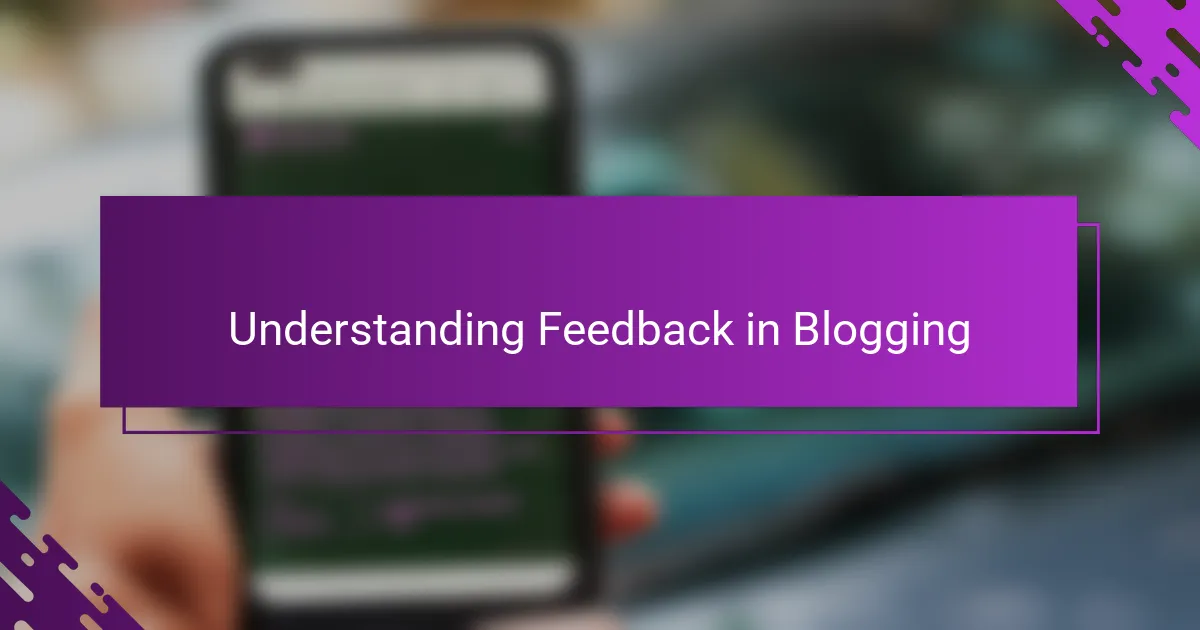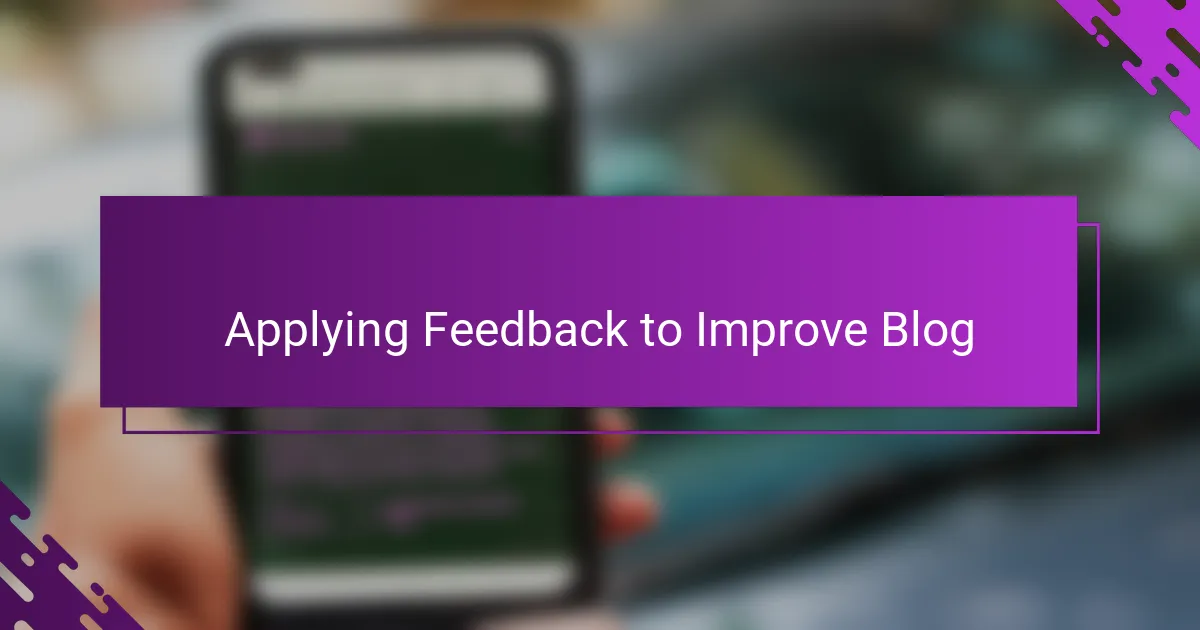Key takeaways
- Understanding and embracing feedback enhances a blogger’s ability to connect with their audience and fosters growth.
- Utilizing tools for structured feedback, like surveys and analytics, yields deeper insights beyond basic comments.
- Analyzing feedback by identifying patterns and themes allows bloggers to prioritize improvements effectively.
- Applying feedback through small, thoughtful adjustments can lead to significant enhancements in reader engagement and satisfaction.

Understanding Feedback in Blogging
Feedback in blogging feels like a conversation with your readers, even when it’s written down and distant. I’ve found that understanding their comments is less about agreeing or disagreeing and more about truly listening—what emotions are they expressing, and what can I learn from that?
Sometimes feedback surprises me. It might highlight something I never noticed about my writing style or the way I connect with my audience. Have you ever felt that mix of vulnerability and curiosity when opening a comment section? That’s the moment where growth begins.
I often ask myself: Is this feedback helping me see my blog from a fresh perspective? If the answer is yes, then even critical remarks become valuable. It’s a reminder that blogging isn’t just about sharing thoughts but about building a meaningful dialogue with readers who care enough to respond.

Importance of Feedback for Bloggers
Feedback has been my secret ingredient for improving as a blogger. When I receive thoughtful comments, I get a genuine sense of connection, like someone is walking alongside me on this blogging journey. Have you noticed how even a small piece of advice can spark new ideas or shift how you approach your posts?
There’s a certain courage in facing feedback—sometimes it stings, sometimes it encourages. But I’ve learned that each reaction is a chance to refine my voice and make my content more authentic. Without that input, blogging would feel like talking into a void, and that sense of isolation is tough to overcome.
More than anything, feedback reminds me that my blog isn’t just about me; it’s about the community I’m creating. When readers take the time to engage, they’re investing in a shared experience. That makes me want to show up better, listen deeper, and write with intention. Don’t you find that kind of accountability pushes you to grow?

Tools for Collecting Wix Feedback
When I first started seeking feedback on my Wix blog, I relied heavily on Wix’s built-in comment system. It was simple to set up and integrated seamlessly, but I quickly realized that it didn’t capture all the insights I craved. Have you ever felt limited by just basic comments, wishing for more structured responses or detailed opinions?
That’s when I discovered tools like Google Forms and Typeform, which I embedded directly into my Wix pages. Using these allows me to create tailored surveys, guiding readers to share specific thoughts about my content. The clear, organized feedback I get now feels like a direct line into my audience’s mind—far more valuable than random comments.
Sometimes, I also use third-party plugins like Hotjar, which offer heatmaps and session recordings. It’s fascinating to watch how visitors interact with my blog, revealing frustrations or moments of engagement I would never have guessed. Have you ever wondered how users actually experience your site beyond what they write? These tools give me an extra dimension of understanding that pure text feedback just can’t provide.

Methods I Used to Analyze Feedback
To really make sense of the feedback I gathered, I started by categorizing comments based on themes like content clarity, tone, and layout. This way, I wasn’t overwhelmed by a flood of mixed opinions but could focus on specific areas that needed attention. Have you ever tried breaking down feedback into bite-sized pieces? It completely changed how actionable it felt for me.
Next, I took a step back and looked for patterns over time rather than reacting to every single comment. That taught me to distinguish between one-off remarks and recurring suggestions, which in turn helped me prioritize changes. It’s like tuning into a chorus instead of just one voice shouting—much more reliable for growth.
I also found it incredibly helpful to respond personally to some feedback, turning it into a conversation. By doing this, I gained deeper insights and made readers feel heard, which motivated them to share even richer feedback. Don’t you think that building a dialogue adds so much more value than just collecting comments? For me, it transformed feedback from static notes into a dynamic learning process.

Lessons Learned from Wix Feedback
Looking back at the feedback I gathered from my Wix blog, one thing became clear: not all criticism is negative. Some pointed remarks actually unveiled blind spots I hadn’t recognized before, pushing me to rethink how I present my ideas. Have you ever received a tough comment that, instead of discouraging you, sparked a moment of clarity? That’s exactly what happened to me.
Another lesson I learned is the importance of patience. Feedback doesn’t always lead to instant improvements, and changes take time to show results. But by trusting the process and consistently reflecting on reader input, I gradually saw my blog evolve in ways that felt authentic and satisfying. It made me realize that blogging growth is more of a marathon than a sprint.
Perhaps most unexpectedly, I discovered that sometimes silence speaks volumes. When certain posts received little feedback, it pushed me to question if I was truly connecting or if the topic missed the mark. That quiet was a call to dig deeper into my audience’s interests rather than assume I knew what they wanted. Have you noticed that kind of subtle nudge in your own blogging journey? It’s a powerful reminder to stay curious and adaptable.

Applying Feedback to Improve Blog
Applying feedback felt like a puzzle where each piece slowly revealed a clearer picture of what my readers truly wanted. I remember revising a post after noticing recurring comments about confusing phrasing. The moment I simplified those sentences, the engagement noticeably improved—it was as if my readers were thanking me for listening.
Sometimes, applying feedback meant making tough choices, like redesigning parts of my blog layout that I was attached to but that readers found clunky. It wasn’t easy letting go, but seeing how those changes boosted reader satisfaction reminded me that adaptability is key. Have you ever had to rethink something you loved for the sake of your audience?
What surprised me most was how small tweaks, inspired by a single insightful comment, could ripple across my entire blog experience. That made me realize that improvement is less about sweeping overhauls and more about consistent, thoughtful adjustments. How often do we overlook the power of tiny changes? For me, applying feedback became an ongoing conversation that keeps my blog alive and evolving.
